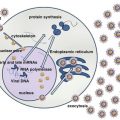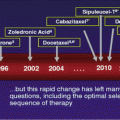Fig. 1
Gastric pathologies induced by Helicobacter pylori infection
At the cellular level, H. pylori infection leads to a Th1 immune response and to a chronic gastritis, followed by an increase in the apoptosis of the gastric epithelial cells resulting in atrophy and leading to a compensative cellular hyperproliferation and an alteration of the differentiation, which is at the origin of the intestinal metaplasia [3]. These metaplastic lesions can further evolve into dysplasia, in situ carcinoma and finally an invasive adenocarcinoma.
Gastric MALT lymphoma (GML) caused by H. pylori infection in humans is one of the most beautiful examples of the role of a chronic infection and inflammation in cancer [26]. MALT-type lymphomas are the most frequent extranodal entities usually found in organs normally devoid of lymphoid tissue such as the stomach. The development of GML in humans is directly related to infection by H. pylori and appears in nearly 1 % of infected individuals. The association of H. pylori infection with GML is strong and causal: it is indeed currently the only cancer which can be cured at an early stage by an antibiotic treatment [25]. Chronic antigenic stimulation exerted by H. pylori on the gastric mucosa induces dense lymphoid infiltrates containing small centrocytic B cells expressing several surface markers typical of marginal zone B cells in normal MALT.
No bacterial virulence factor has yet been clearly associated with this disease [12]. A better understanding of the pathophysiology of this lymphoma has been hampered by the difficulty in obtaining primary xenografts from surgical specimens of GML patients. Based on the use of animal models, it is now admitted that the inflammatory, molecular and immunological contexts of the host prior to H. pylori infection are probably essential contributors to GML pathogenesis [4].
3 H. pylori Virulence Factors
H. pylori has developed a unique set of factors (Table 1), actively supporting its successful survival and persistence in its natural hostile ecological niche, the human stomach, throughout the individual’s life, unless treated. In the human stomach, the vast majority of H. pylori cells are moving in the mucus layer lining, but a small percentage adhere to the epithelial cell surfaces.
Table 1
List of bacterial factors of H. pylori associated with gastric adenocarcinoma
Name | Function | Targets | Bacterial genotype associated with cancer |
|---|---|---|---|
BabA | Adhesin | Lewis antigen | babA2+ |
SabA | Adhesin | Sialyl-Lewis antigen | sabA+ |
OipA | Adhesin | Unknown | oipA+ |
HopQ | Adhesin | Unknown | hopQ1 |
HomB | Adhesin | Unknown | homb+ |
VacA | Vacuolating cytotoxin | RTPβ receptor | vacA s1m1 |
T4SS | Type 4 secretion system encoded by the cagPAI | β1 integrin | cagPAI+ |
CagA | Oncoprotein | Cell-cell junctions proteins (ZO-1, JAM and E-cadherin), β-catenin, kinase PAR1, Src kinases, Erk1/2 kinases, SHP2 phosphatase, c-Met receptors | cagA+ |
H. pylori is one of the most genetically diverse bacterial species known, and it is equipped with an extraordinarily large set of outer membrane proteins (OMPs), whose role in the infection and persistence process is crucial. The large group of OMPs contains adhesins (BabA and SabA), adherence-associated lipoproteins (AlpA/B) and inflammatory OMPs (OipA or HomB) that mediate H. pylori binding to the host cell membrane. Some of these OMPs are associated with more severe pathologies, such as HomB in ulcers [19] and cancer [10]. The babA genotype correlates with the highest incidence of ulceration and gastric cancer [24].
One of the most extensively studied toxins produced by H. pylori is the vacuolating cytotoxin A (VacA). Infection with H. pylori strains containing the toxigenic allelic s1 form of VacA is associated with an increased risk of peptic ulceration and gastric cancer. Once internalised into the cell, VacA induces severe “vacuolation” characterised by the accumulation of large vesicles. VacA also exerts effects on target cells, including disruption of mitochondrial functions, stimulation of apoptosis and blockade of T-cell proliferation [20].
The oncoprotein CagA encoded by the cagA gene of the cag pathogenicity island (cagPAI) is one of the most studied virulence factors for H. pylori. The cagPAI encodes proteins assembling a type 4 secretion system (T4SS), which interacts with the α5ß1 integrin at the surface of the gastric epithelial cells and allows the injection of different bacterial effectors including CagA and pro-inflammatory components of the bacterial peptidoglycan directly into the cytoplasm of the host cell [29]. CagA thereby affects several signalling pathways and cell proliferation and differentiation states [1]. A direct causal link between CagA and gastric carcinogenesis was proven in transgenic mice expressing CagA: these mice spontaneously develop gastric polyps and adenocarcinoma, revealing CagA as the first bacterial oncoprotein [18].
4 H. pylori-Mediated Inflammatory Response
The role of inflammation in H. pylori infection is also of major importance as it triggers the outcome of this chronic infection.
The activity of the inflammatory response (polymorphonuclear and lymphoplasmacytic infiltration) as well as the preneoplastic lesions such as atrophy or intestinal metaplasia is evaluated during histological examination of gastric biopsies according to the Sydney system. The development of chronic atrophic gastritis and other preneoplastic lesions is associated with decreased pepsinogen I/II ratio, increased plasma gastrin concentration and a Th1 polarisation of the immune response (IFN, IL-1β, IL-8 and TNF) that will inhibit somatostatin production and therefore stimulate gastrin production. The TNF and IL-1β also inhibit the acid production by the parietal cells.
The tendency of an immune response to become polarised towards Th1 or Th2 effectors is influenced by a combination of host genetic factors and the type and amount of antigen that is encountered. IL-12 and IFN-γ are important for induction of Th1 response, whereas IL-4 and IL-13 play critical roles in promoting Th2 response. However, in many cases, it is still not understood why a Th1 or Th2 response is preferentially induced. Of particular interest, the immune response to Helicobacter infection can be modulated experimentally in mice by co-infection with nematodes towards a Th2 type that protects against gastric atrophy [8]. Such modulation is mediated by downregulation of the Th1 cytokines TNFα and IL-1β and higher levels of the Th2 cytokines IL-4 and IL-10 [9].
Polarisation towards a Th1 profile can contribute to the development of peptic ulcers and other severe mucosal pathology, while on the other hand, activation of a Th2 cell response results in amelioration of the gastritis. Therefore, it has been deduced that an uncontrolled Th1 cell response to H. pylori infection results in persistence of inflammation and disease, whereas, in contrast, a Th2-mediated response reduces the pro-inflammatory immune effects [17].
In humans, the innate immune response caused by the infection is not sufficient to eliminate the pathogen. Regulatory T cells recruited in the gastric mucosa during infection could also play a role in the development and persistence of chronic inflammation via the production of cytokines that regulate the inflammatory response such as TGFβ and IL-10. Moreover, immune response contributes to chronic gastritis ultimately leading to the development of more severe disease in some individuals.
H. pylori strains from East Asia are associated with a high cancer risk and African strains with a low cancer risk in African populations despite the fact they are highly infected. This so-called African enigma probably reflects the modulation of the inflammatory process initiated by the infection, towards a non-neoplastic outcome. The available scientific evidence supports the role of the following factors, listed in order of their possible importance in explaining the enigma: the oncogenic potential of different bacterial genotypes, the modulation of the immune response to Helicobacter infection towards a Th2 type and dietary influences and host genetic susceptibility [9].
Stay updated, free articles. Join our Telegram channel

Full access? Get Clinical Tree





